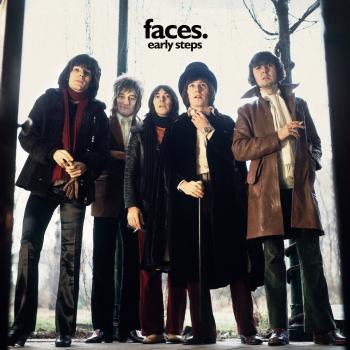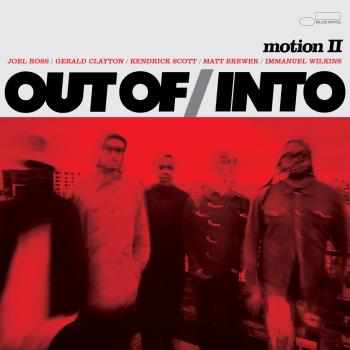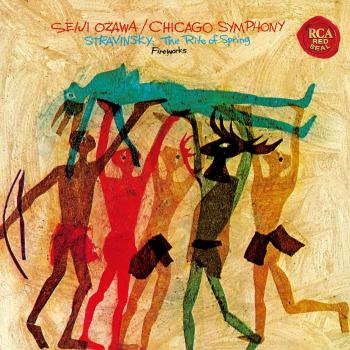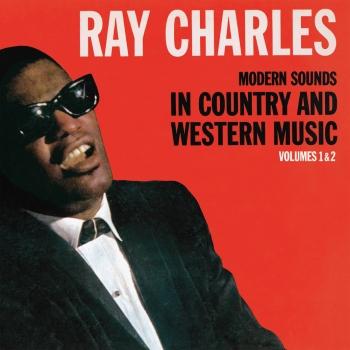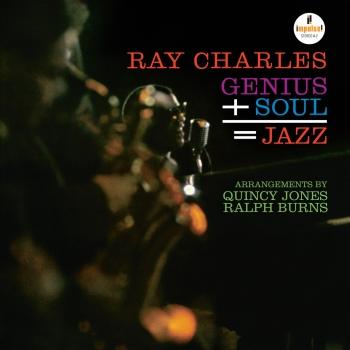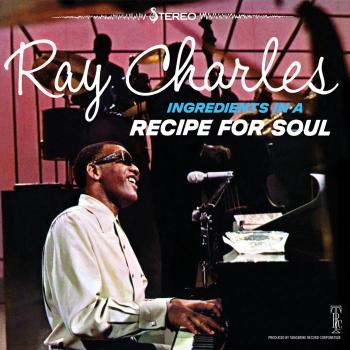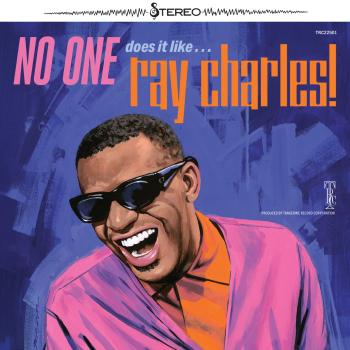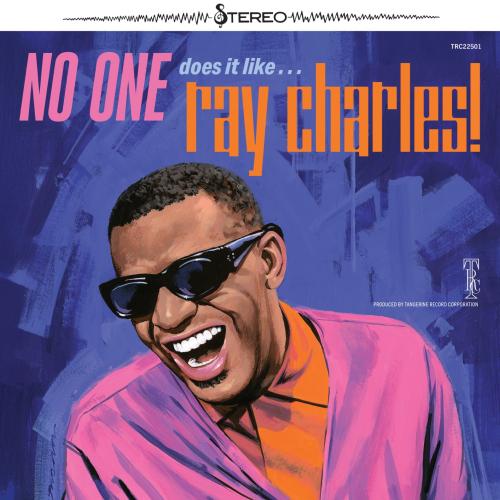
No One Does It Like... Ray Charles (2025 Remaster) Ray Charles
Album info
Album-Release:
2025
HRA-Release:
21.11.2025
Album including Album cover
- 1 My Baby Don't Dig Me (2025 Remaster) 02:38
- 2 Without Love (There Is Nothing) (2025 Remaster) 03:37
- 3 The Brightest Smile In Town (2025 Remaster) 02:50
- 4 Hide Nor Hair (2025 Remaster) 03:12
- 5 My Baby (I Love Her, Yes I Do) (2025 Remaster) 03:04
- 6 No One (2025 Remaster) 03:11
- 7 Don't Set Me Free (2025 Remaster) 02:39
- 8 Something's Wrong (2025 Remaster) 02:51
- 9 At The Club (2025 Remaster) 03:01
- 10 Worried Life Blues (Someday Baby) (2025 Remaster) 03:07
- 11 Who You Gonna Love (2025 Remaster) 02:03
- 12 My Heart Cries For You (2025 Remaster) 02:49
Info for No One Does It Like... Ray Charles (2025 Remaster)
At the height of his early 1960s creative explosion, Ray Charles was moving faster than the industry could keep up. His groundbreaking albums were redefining popular music, while several hit singles never found a home on LP. Now, for the first time, those non-album gems are finally brought together on No One Does It Like... Ray Charles!, a newly curated Tangerine Masters release that captures the genius in his prime.
The album gathers a string of R&B hits, including “No One,” “Hide Nor Hair,” “At the Club,” “Don’t Set Me Free,” and “My Heart Cries for You,” restored and remastered with care by multi-Grammy winner Michael Graves. Pressed on tangerine vinyl and mastered by Jeff Powell, it feels both archival and immediate, a missing chapter made whole.
Featuring a period-perfect cover illustration by renowned artist Paul Mann, the collection has been curated, designed, and presented as the Ray Charles album that might have been released alongside his greats of the era. Thanks to The Ray Charles Foundation and the Tangerine Masters series, No One Does It Like... Ray Charles! does not just fill in a gap in his discography, it restores a crucial part of his creative story.
"A discography can define legacy, it can define a tenure of greatness, but to appreciate the gifts of Ray Charles, one has to avoid taking such a wide-lens approach, which is a way of saying that each Ray Charles song is a universe," writes award-winning poet, essayist, and cultural critic Hanif Abdurraqib in an exclusive essay penned expressly for this new release. "No One Does It Like...Ray Charles! is an offering which makes that plain....All of the songs on this album existed, somewhere, before this, stretched out alongside the massive career of Ray Charles. But this is the first time they've been curated and organized in one single place. Before this, these songs existed primarily as scattered singles or one-off bonus tracks, but they all came out of an Era where Charles was at his best, a 1960s run where he showcased his brilliance, and his range, and also a decade where he was at his most prolific, releasing multiple albums every year. Because of this, it can feel like we have all heard Charles at the highest level, we have witnessed and dissected his greatness, and we have the massive run of albums to prove it all.
"To listen through this body of work is to hear what I think is Ray Charles at the height of his powers, specifically as a singer. Attacking each note in each song until he can wring everything out of it. To put it another way, this is Ray Charles at the height of his power of feeling. It is easy to look at these specific songs and say Ray Charles had the blues, but the blues are a primary color. In order for them to become touchable, in order for them to actually live outside of the body, they have to be intertwined with other colors. The blues are made up of many parts: longing, fear, desire. I love a singer who can show you how the paint is mixed."
No One Does It Like...Ray Charles! marks the latest installment in the ongoing Tangerine Master Series, following the arrival earlier this month of 1970's out of print classic Love Country Style, available everywhere now for the first time since its original release. A fan favorite that's one of the finest examples of Charles' crossover work, Love Country Style is the most soulful of his country records, as well as arguably the album that's the most connected to the current sound of today's country superstars. The album finds Charles once again embracing his love for the genre by delivering heartfelt renditions of songs by Mickey Newbury and Jimmy Webb with his signature blend of soul and sophistication. Backed by lush gospel-tinged arrangements, songs like his iconic version of "Ring of Fire" and "Don't Change On Me" (which hit the top 20 at R&B as well as the overall top 40) highlight Charles's unrivaled ability to transform country standards into something unmistakably his own. Out of print since its original release more than 50 years ago, Love Country Style now finally returns, fully restored and remastered in cooperation with the Ray Charles Foundation.
Ray Charles
Digitally remastered
Ray Charles
The name Ray Charles is on a Star on Hollywood Boulevard’s Walk of Fame. The name Ray Charles designates a superstar worldwide. His bronze bust is enshrined in the Playboy Jazz Hall of Fame. There is the bronze medallion that was cast and presented to him by the French Republic on behalf of the French people. In just about every Hall of Fame that has anything to do with music, be it Rhythm & Blues, Jazz, Rock & Roll, Gospel or Country & Western, Ray’s name is very prominently displayed. There are many awards given to him in the foregoing categories as proof.
Probably the strongest element in Ray Charles’ life, and the most concentrated driving force, was music. Ray often said, “I was born with music inside me. That’s the only explanation I know.”
Ray Charles was not born blind. In fact, it took almost seven years for him to lose his sight in its entirety, which means he had seven years to see the joy and sadness of this big wonderful world – a world he would never see again. As a seven year old child, in searching for light, he stared at the sun continuously, thereby eliminating all chances of the modern-day miracle, cornea transplants – a surgery unheard of in 1937.
Perhaps the reason that Ray Charles made music his mistress and fell madly in love with the lady is that music was a natural to him. Ray sat at a piano and the music began; he opened his mouth and the lyrics began. He was in absolute control.
But the rest of his life was not quite so simple. Ray was born at the very beginning of the Great Depression – a depression that affected every civilized country in the world. Ray was born in 1930 in Albany, Georgia, the same year that another Georgia native by the name of Hoagy Carmichael, was already making his mark on the world. In 1930, the year of Ray’s birth, Hoagy recorded a song that became an all-time classic and remains so to this day; a song titled “Stardust.” It’s ironic that these two Georgia natives would someday cross paths again, as they did 30 years later when Ray Charles was asked by the State of Georgia to perform, in the Georgia Legislative Chambers, the song they had selected as their state song. That song was Ray’s version of “Georgia,” written by Hoagy Carmichael. Hoagy, who unfortunately was too ill to attend the event, was listening via telephone/satellite tie-up.
Ray’s mother and father, Aretha and Bailey, were “no-nonsense” parents. Even after Ray lost his sight, his mother continued to give him chores at home, in the rural area in which they lived, such as chopping wood for the wood burning stove in the kitchen in order for them to prepare their meals. Chores such as this often brought complaints from the neighbors, which were met with stern words from Mrs. Robinson. She told them her son was blind, not stupid, and he must continue to learn to do things, not only for himself, but for others as well. Unfortunately, Ray lost the guidance of his mother and the counseling of his father at a very young age. At 15 years old, Ray Charles was an orphan, but he still managed to make his way in this world under very trying conditions; living in the South and being of African-American heritage, plus being blind and an orphan.
Ray refused to roll over and play dead. Instead he continued his education in St. Augustine, at Florida’s State School for the Deaf and Blind. A few years later, Ray decided to move. His choice was Seattle, Washington. It was in Seattle that Ray recorded his first record. It was also in Seattle that the seed was planted for a lifelong friendship with Quincy Jones. More information please visit the Ray Charles homepage.
This album contains no booklet.



